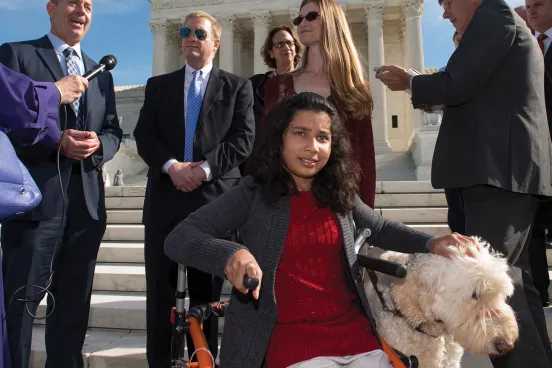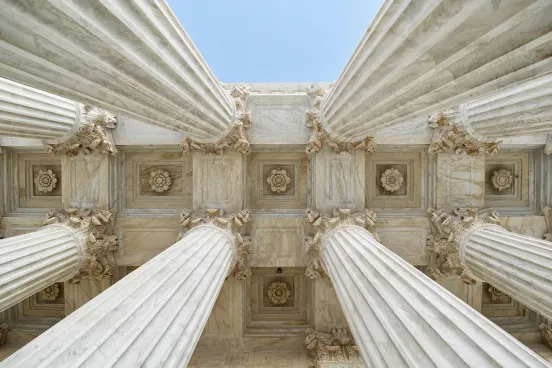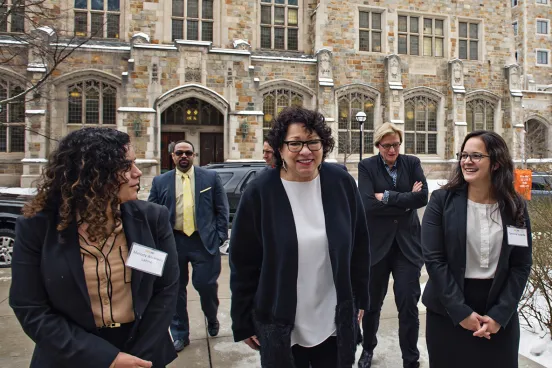
Michael Bobelian’s interest in the U.S. Supreme Court was piqued at the University of Michigan, where a history class with the late Professor Sidney Fine and law classes with Professors Richard Friedman, Tom Green, and James Boyd White left lasting impressions on him.
“Those different perspectives planted the seeds for wanting to write a book about the political and social history of the Supreme Court,” says Bobelian, ’98.
Bobelian, a journalist who has reported on the Supreme Court and other legal topics since 2003, explores the controversial Supreme Court nomination of Abe Fortas in his new book, The Battle for the Marble Palace: Abe Fortas, Earl Warren, Lyndon Johnson, Richard Nixon, and the Forging of the Modern Supreme Court (Schaffner Press, 2019). While popular opinion among Court followers is that Robert Bork’s failed Supreme Court nomination in 1987 set a political precedent for how justices are confirmed, Bobelian says it is the often-forgotten nomination of Fortas in the late 1960s that was the turning point for the politicization of the Supreme Court.
“The conventional wisdom is that the Bork nomination set the stage for the big partisan confirmation battles we have today,” Bobelian says. “When I looked at the history of nominations dating back to George Washington, I saw that there was a switch in 1968 involving Abe Fortas. It made me ask why that transformation took place. My book tries to explore that issue and introduce readers to a fresh understanding of how we got to where we are politically with the Supreme Court.”
Fortas, an associate justice, was nominated by President Lyndon Johnson to succeed retiring Chief Justice Earl Warren. A longtime friend and adviser to Johnson, Fortas was the first nominee for the top job on the Court to testify before a Senate committee. The Senate discovered that he regularly attended White House meetings and shared Court deliberations with Johnson. It also was brought to light that Fortas accepted $15,000 in private funds to teach seminars at American University, which led to Fortas being filibustered by the Senate and Johnson withdrawing his nomination.
“Abe Fortas was the first and only victim of a filibuster. People were so hell-bent on stopping him from becoming the chief justice that they resorted to deploying the Senate’s ultimate parliamentary weapon,” says Bobelian, who noted that other unprecedented strategies also were used to discredit Fortas. One involved South Carolina Sen. Strom Thurmond, a vocal opponent of Fortas, who organized the Fortas Film Festival, during which pornographic films were broadcast in the Senate to highlight Fortas’s moral turpitude. “If you think of unorthodox, unconventional, and outlandish tactics, that ranks really high, and it shattered all the norms that had governed the confirmation process.”
A former associate at a Wall Street law firm, Bobelian says he enjoys writing about the law. He had been toying with the idea of going to journalism school when the September 11 attacks gave him the impetus to make a change. He graduated with a master’s degree from the Columbia University Graduate School of Journalism, and began covering white-collar crime and corporate corruption—think Enron, WorldCom, and Bernie Madoff—before writing about the Supreme Court for Forbes.com and other publications.
Bobelian spent years researching The Battle for the Marble Palace—including untold hours at U-M’s Bentley Historical Library (which holds the papers of Sen. Philip Hart, a 1937 Law School graduate who led the pro-Fortas camp) and the Gerald R. Ford Presidential Library—and amassed nearly 10,000 documents, memos, congressional testimony, and audio files of conversations involving Johnson and Richard Nixon, who was staging a presidential campaign in 1968.
Bobelian says his biggest takeaway from the book is “that between Lyndon Johnson, Richard Nixon, and the Senate’s willingness to break with custom, we established the template for modern-day judicial politics. The Fortas nomination set in motion the process of a hyper-politicized Supreme Court. I hope that if people see the origins of that process and its negative consequences that reverberate to this day, both sides might back away from their extreme partisanship.”







